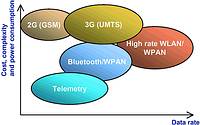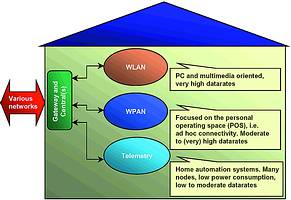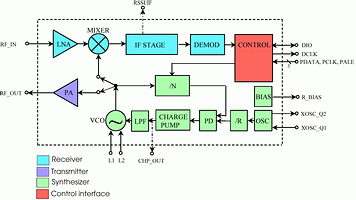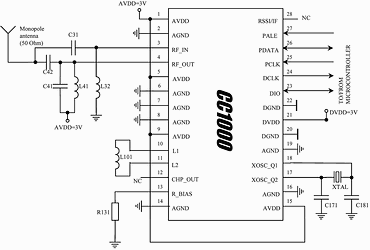
Wireless communication is expected to be a key technology for the home automation market, as the use of RF-signals is highly desirable or necessary due to the ability to penetrate walls and ceilings. Also, wireless technology significantly reduces system installation cost. Chipcon's CC1000 transceiver offers an outstanding solution to the most demanding home automation systems which typically require very low power consumption and very low cost.
With increasingly mobile lives, the desire to be connected anywhere and the demand for convenience on every level, consumers are rapidly adapting to wireless devices for a variety of personal and professional needs. The new wireless revolution, using short-range radio frequency (RF) communication to do away with wires in homes and offices, is creating an unprecedented demand for cost-effective RF-ICs providing maximum integration, universal applicability, low power and flexibility. Today the consumer two-way RF communications market can roughly be split into four categories:
* Mobile telephony (2G, 2,5G and 3G). These are the most complex and costly systems. Typically they also require the highest power consumption because of the need for high computing power and stringent requirements on transmitted signal spectrum and the sensitivity and selectivity of the receiver.
* High data rate WLAN (wireless local area network) and WPAN (wireless personal area networks). These standards have main focus on achieving very high data rates for short range communication. Achieving low power consumption is secondary. IEEE 802.11b/a/g are examples of this. HomeRF and the upcoming IEEE 802.15.3 WPAN standard are also in this category.
* Bluetooth (ie WPAN with medium data rate). This technology is optimised for short range cable replacement, ie for the 'Personal Operating Space'. The most typical application example is communication between a mobile phone (or PDA) and a laptop. For many handheld Bluetooth applications, low power consumption is very important.
* Telemetry. These systems typically require a data rate of only a few Kbps as typical functionality is simple control and monitoring functions. The communication distance is in the range of a few metres up to a hundred metres. Typical applications are home automation, remote keyless entry, automatic meter reading and alarm and security systems, electronic toys and game pads and audio and voice applications.
Figure 1 shows a very simplified picture of the different RF communication applications, and how they can be categorised according to cost, complexity, power consumption and data rate.

This article focuses on category 4; the telemetry systems, and more specifically on home automation which is expected to be a very important and fast growing field within this wireless application segment. These telemetry systems have common requirements for some of their most important features. For example, many of these products are battery-operated and low current consumption is therefore essential to achieve maximum battery life. Very often these products are physically small and require highly integrated single-chip solutions to minimise the size and to reduce the number of components required. In many cases a flexible solution that can be programmed for worldwide use is essential. Chipcon RF-ICs meet these and other stringent requirements and, as a result, have proved to be an ideal solution for many products in many of these sectors.
Wireless home automation systems
The field of home automation is expanding rapidly as electronic technologies converge. The home network now encompasses communications, entertainment, security, convenience and information systems.
Wireless communication is expected to be a key technology for the home automation market. In several cases the use of RF-signals is highly desirable or necessary due to the ability to penetrate walls and ceilings. Wireless communication also significantly reduces system installation cost. Typical applications within home automation are:
* Remote metering/control: electricity, gas, water.
* Alarm/security: fire, intruder, panic.
* Power control: power outlets, light switches, heating.
* Comfort functions: blinds/shades/rollers/curtains, window control, garage door openers, building keyless entry.
* White goods: freezer, refrigerator, oven/microwave.
Generally, there is no need for high data rates for these home automation applications as most functions are related to simple control and monitoring - typical data rates of 1-40 Kbps. However, what is especially important for home automation is the need for very low cost and very low power solutions. In a few years a house can typically have a control and monitoring system with 50-200 intelligent radio nodes, used for eg remote lighting control, remote heating control (wireless thermostat) etc. With so many radios it is obviously very important to maximise battery lifetime to keep maintenance cost down, eg for wireless light switches it is costly and cumbersome to replace the battery more often than every two years.
It is more and more recognised that Bluetooth is not the ideal solution for all short range radio communication systems. eg for a wireless light switch one does not need 1 Mbps raw data rate capability and complex software stacks. Much simpler and less power hungry solutions can be used. Preferably such a system should be able to operate with an 8 bit microcontroller with only a few KB of program memory.
Also, the required communication range (for a given transmitted output power) for a home automation system is generally longer compared to Bluetooth and WLAN. Finally, the cost targets of a complete home automation communication/system chip set is less than half of the cost of Bluetooth. This requires completely different system thinking and specification.
Of course, moderate/low datarate wireless networks cannot be used for all home network applications, eg data transfer between PCs, high-speed Internet access and steaming video applications would require WLAN or Bluetooth. However, having a central/gateway can enable very useful interactions of the various types of home networks. For the low data rate control/monitoring networks it is desirable to have remote control of all these kinds of applications. In principle this can be done from anywhere in the world through any terminal (PC, mobile phone) which has Internet access. The home must be equipped with an Internet gateway. This gateway could also have a central/master/bridge function for the various kinds of home networks installed. Then the mobile phone or PDA (or a combined device) can control the lights/heating by going through the central/gateway using eg Bluetooth communication.
Figure 2 shows how the various networks from Figure 1 can co-exist and interact within a home. Each system is used for what it is optimised for, thus providing the overall optimum performance/cost ratio.

In Europe the licence-exempt band centred at 433,92 MHz (about 1,7 MHz wide) is very important for general short range low power radio communication, and the more regulated 868-870 MHz band is also gaining popularity. In the US the frequency bands 260-470 MHz and 902-928 MHz play a similar role for general short range communication.
The main advantages with operation at these frequencies are the significantly lower power consumption and longer communication range compared to operation at higher frequencies (2,4 GHz). It is also an advantage that interference from Bluetooth and WLAN will be negligible.
The protocol used for the various home automation systems must be tailored for the specific application needs and the requirements on power consumption.
In a typical home automation network there are strict requirements on the power consumption of the radio transceiver during reception, as this mode dominates the average power consumption. Besides dissipating as small an amount of power as possible in active mode, a very common technique for power reduction is to use time-division multiplexing and/or polling. During transmit mode, it is normally acceptable to have much higher power consumption as long as the transmit-time/receive-time ratio is low and the battery is capable of delivering the peak currents without dropping the supply voltage below the minimum acceptable limit.
For home automation and building instrumentation, proprietary low power solutions dominate. However, there are also strong initiatives for standardisation within this segment. The European Konnex Association works with specifying a system based on operation in the 868 MHz range. The ZigBee Organization is developing a standard for low cost low power wireless home automation devices. ZigBee works closely with the Task Group IEEE 802.15.4 which is developing the PHY and MAC layers of the low rate WPAN standard.
A highly integrated transceiver
Chipcon's CC1000 integrated circuit is designed primarily for FSK systems in the ISM/SRD bands at 315, 433, 868 and 915 MHz, but can easily be programmed for operation at other frequencies between 300 and 1000 MHz. The data rates supported are from 0,6 to 76,8 Kbps. The device operates from 2,1 to 3,6 V making it ideal for battery applications using a single lithium manganese dioxide 3,0 V coin cell or a lithium thionyl chloride 3,6 V cell. For operation at 433 MHz the current consumption is only 7,4 mA in receive mode and from 5,3 mA up to 26,7 mA in transmit mode depending on the output power. For operation at 868/915 MHz the current consumption in receive mode is 9,6 mA and from 8,6 mA transmit mode.
The output power can be programmed in 1 dB steps up to 10 dBm at 433 MHz and up to 5 dBm at 868/915 MHz. In power-down mode the device draws merely 0,2 µA, another very important feature for battery applications.
The CC1000 has an integrated PLL that can be programmed in 250 Hz steps making crystal temperature drift compensation possible. This also makes the device suitable for multichannel systems and frequency hopping protocols.
The device offers an integrated bit synchroniser and RSSI and is easily interfaced to any microcontroller through five I/O lines. CC1000 comes in a TSSOP 28 package, specified over -40 to 85°C.
The block diagram (Figure 3) shows the high level of integration achieved with CC1000. All blocks needed to make a complete RF transceiver with synchronised digital data in/out are integrated on-chip. Even with the high integration, CC1000 is very flexible and therefore suited for a variety of systems.

The very sensitive receiver combined with a high output power makes it possible to build very low power battery operated systems while still achieving a long and reliable communication range. This also implies that for shorter communication distances one has a significant link margin. This is especially important for home automation systems where the transmission conditions can vary widely due to various materials used in building walls and ceilings. The CC1000's multichannel possibilities are a great advantage when designing equipment that has to be operated under different regulatory restrictions. Solutions can be developed that can be reused in different markets. Automatic frequency selection and frequency hopping protocols may be used to increase the reliability of the system as the frequency bands used for licence-free short-range communications become more and more crowded.
Very few external components are required to make a complete transceiver. The application circuit is shown in Figure 4.

The CC1000 is supported by CC1000DK Development Kit which provides a complete reference design with schematics, bill of materials and layout for the developer. The SmartRF Studio software package generates all configuration data used by the microcontroller.
Summary
Wireless communication is expected to be a key technology for the home automation market, as the use of RF-signals is highly desirable or necessary due to the ability to penetrate walls and ceilings. Besides wireless technology significantly reduces system installation cost. The CC1000 transceiver offers an outstanding solution to the most demanding home automation systems which typically require very low power consumption and very low cost.
For further information contact Kevin Jurrius, Components & System Design, 011 391 3062.

© Technews Publishing (Pty) Ltd | All Rights Reserved